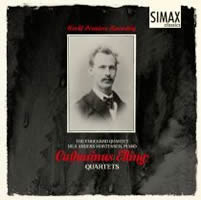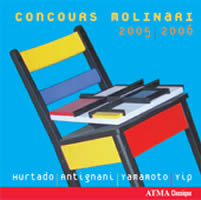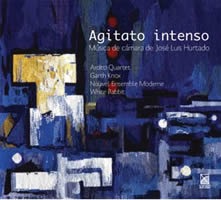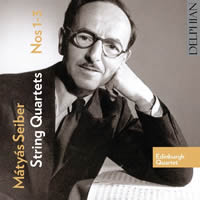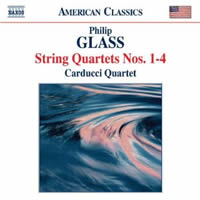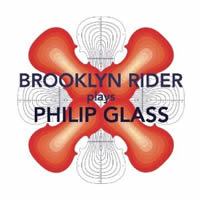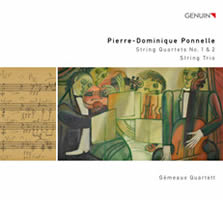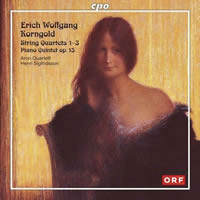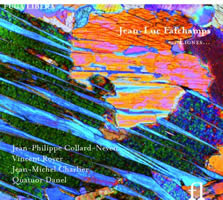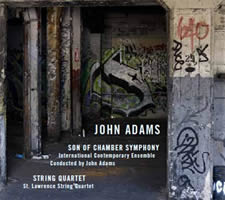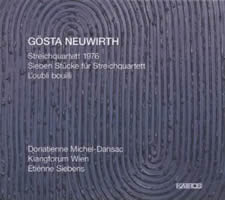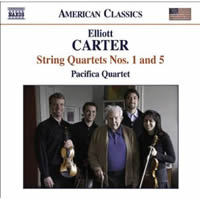String Theory 6: 27 Quartets, etc.
|
Grant Chu Covell [March 2012.] [An enormous stack of string quartet releases beckons. I’ll try for concision rather than rumination in this first of several posts. G.C.C.]
Catharinus ELLING: String Quartet in D major (ca. 1897); String Quartet in A minor (ca. 1903); Piano Quartet in G minor (ca. 1901). The Engegård Quartet: Arvid Engegård, Atle Sponberg (vlns), Juliet Jopling (vla), Jan-Erik Gustafsson (vlc); Nils Anders Mortensen (pno). Simax PSC 1304 (1 CD) (http://www.simax.no/). Distributed in the US by Naxos (http://www.naxos.com/). Catharinus Elling was born in Oslo in 1858. A recommendation from Grieg established the composer in Berlin where he studied with Herzogenberg, a Brahms ally. Elling brought his family back to Oslo in 1896, effectively quit composing in 1927, and died in 1942. Elling occupies a less well-known gap in conservative Norwegian Romantic music. While he overemploys sequences and patterns, it is nice to be reminded how Schubert, Mendelssohn or Brahms might have tackled a modulation or transition. In sum, however, were it not for these passionate performers, the pieces would soon pall.
“Concours Molinari: 2005-2006.” Kazutomo YAMAMOTO: Mare Taranquitatis (2004?). José Luis HURTADO: L’ardito e quasi stridente gesto (2005-06). Luca ANTIGNANI: Il funerale del carnevale (2004?). Stephen YIP: Yi Bi (2004). Quatuor Molinari: Olga Ranzenhofer, Johannes Jansonius (vlns), Jasmine Schnarr (vla), Julie Trudeau (vlc). Atma ACD2 2368 (1 CD) (http://www.atmaclassique.com/). Distributed in the US by Naxos (http://www.naxos.com/). José Luis HURTADO: Lasciare (2007)1; Agitato intenso (2006)2; Letargo e Instante (2008-09)3; L’ardito e quasi stridente gesto (2005-06)4; Alla tessitura (2008)5. White Rabbit Ensemble1,2; Nouvel Ensemble Moderne3, Jacques Drouin3 (pno), Lorraine Vaillancourt3 (cond.); Arditti Quartet4: Irvine Arditti, Ashot Sarkissjan (vlns), Ralf Ehlers (vla), Lucas Fels (vlc); Garth Knox5 (vla). Urtext JBCC 186 (1 CD) (http://www.urtextonline.com/). Distributed in the US by Naxos (http://www.naxos.com/). Three cheers to the Molinari’s international bi-annual composition competition. Winners get performances and recordings. I favor the 3rd-place winners in the 2005-06 contest: Antignani and Yip’s playful quartets explore wider techniques and colors. Perhaps the Yamamoto and Hurtado were easier to execute? Considering the title’s intended pun, the L’ardito Arditti benefit from a superior recording. Urtext offers onstage seating whereas Atma provides obstructed balcony views. We discover that Hurtado has mastered space, gesture and energy. Lasciare is an uncharacteristic Pierrot quintet and Alla Tessitura provides solo viola scribbles. Two grand duos are on display: Agitato intenso for clarinet and piano, and Letargo e Instante for piano and chamber orchestra.
Mátyás SEIBER: String Quartet No. 1 (1924); String Quartet No. 2 (1934-35); String Quartet No. 3, “Quartetto Lirico” (1948-51). Edinburgh Quartet: Tristan Gurney, Philip Burrin (vlns), Michael Beeston (vla), Mark Bailey (vlc). Delphian DCD34082 (1 CD) (http://www.delphianrecords.co.uk/). Distributed in the US by Allegro Music (http://www.allegro-music.com/). Born in Hungary, Seiber eventually made his way to England’s musical life which he variously enriched. In the years between his First and Second, he played cello in a cruise ship orchestra. Later he taught jazz analysis. He wrote the music to an animated version of Animal Farm in 1954 (Britain’s first animated feature), and his pop single, “By the Fountains of Rome,” was a hit on the UK charts in 1956. He also wrote and published accordion music under the pseudonym G. S. Mathis. Seiber’s three quartets stand in the shadow of Bartók, Schoenberg and Shostakovich absent a hint of Seiber’s popular capabilities. Delphian’s brittle resonance barely encourages the Edinburgh, but it’s a step ahead of EMI’s Amadeus recording (reissued as EMI 7243 5 85150 2 2). I’m left wanting to hear more Seiber.
Philip GLASS: String Quartet No. 1 (1966); String Quartet No. 2, “Company” (1983); String Quartet No. 3, “Mishima” (1985); String Quartet No. 4, “Buczak” (1989). Carducci String Quartet: Matthew Denton, Michelle Fleming (vlns), Eoin Schmidt-Martin (vla), Emma Denton (vlc). Naxos 8.559636 (1 CD) (http://www.naxos.com/). Philip GLASS: Suite from “Bent” for String Quartet (1997); String Quartet No. 1 (1966); String Quartet No. 2, “Company” (1983); String Quartet No. 3, “Mishima” (1985); String Quartet No. 4, “Buczak” (1989); String Quartet No. 5 (1991). Brooklyn Rider: Johnny Gandelsman, Colin Jacobsen (vlns), Nicholas Cords (vla), Eric Jacobsen (vlc). Orange Mountain Music 0074. (2 CDs) (http://www.orangemountainmusic.com/). Distributed in the US by Harmonia Mundi (http://www.harmoniamundi.com/). The Carducci bring freshness to well-worn Glass, tackling the first four as if Borodin or Brahms, reveling in the fundamentally expressive harmonies and deftly applying articulation in order to sustain interest. The early dissonant First illuminates a path Glass did not pursue: In its repeating tocsins we hear Feldman’s gestures accelerated and repeated. Brooklyn Rider collects five quartets and music from the film Bent. Glass’ mechanisms grow lumpy when they’re not precise. This is not a quartet so much as four people treading water. Mishima sounds more lived in than Company or the Fifth. Why does Glass’ house label push these performances? Let’s hope Naxos has the Carducci lined up for Nos. 5 and 6.
Pierre-Dominique PONNELLE: String Quartet No. 1 (2005); String Quartet No. 2 (2006); String Trio (2007). Gémeaux Quartett: Anne Schoenholtz, Manuel Oswald (vlns), Sylvia Zucker (vla), Uli Witteler (vlc). Genuin GEN 10163 (1 CD) (http://www.genuin.de/). Distributed in the US by Naxos (http://www.naxos.com/). The quartets reflect Ponnelle’s travels and work as a conductor across Russia. Bashkir tunes bump into the legendary B-A-C-H motive in the First, and the Second contrasts Sufi themes with the hustle and bustle of Western life, with Schubert echoes haunting a climax. Doubling the length of Quartet No. 1, the grand, 28-minute Trio is an eloquent statement. The Gémeaux’s lineup has shuffled since this 2010 release, and I hope they maintain the same artistic level.
Erich Wolfgang KORNGOLD: Piano Quintet, Op. 15 (1921); String Quartet No. 1, Op. 16 (1920-23); String Quartet No. 2, Op. 26 (1933); String Quartet No. 3, Op. 34 (1945). Aron Quartet: Ludwig Müller, Barna Kobori (vlns), Georg Hamann (vla), Christophe Pantillon (vlc); Henri Sigfridsson (pno). cpo 777 436-2 (2 CDs) (http://www.cpo.de/). Distributed in the US by Naxos (http://www.naxos.com/). Written contemporaneously, the Piano Quintet and Quartet No. 1 bespeak tradition while pushing at its boundaries. The delightful Second aptly proves why Korngold was considered the last Viennese composer: Its 22 finely wrought minutes close with a throwback Waltz. The Third reclaims the First’s twisting chromatics. It’s possible to hear this double-set as a meta-quartet: the sugary Second functioning as Scherzo. Definitely the Aron has the most fun with it.
“…Lignes…” Jean-Luc FAFCHAMPS: Les désordres de Herr Zoebius (1992-2003); Back to the Voice (1998); Bryce (1998); Lettre Soufie: Z(1) (2003). Jean-Philippe Collard-Neven (pno), Vincent Royer (vla), Jean-Michel Charlier (clar), Quatuor Danel: Marc Danel, Gilles Millet (vlns), Vlad Bogdanas (vla), Guy Danel (vlc). Fuga Libera FUG537 (1 CD) (http://www.fugalibera.com/). Distributed in the US by Allegro Music (http://www.allegro-music.com/). Fafchamps is familiar from his turn as Ictus’ pianist. Curiously, Back to the Voice, written for his instrument, is the least distinctive. A string quartet, Les désordres de Herr Zoebius, and Bryce, for quartet plus clarinet, offer the most inventive and vibrant writing. Herr Zoebius winds and twists as an unsolved mystery. Viola and piano duo Royer and Collard-Neven are joined with electronics for Lettre Soufie: Z(1), part of a larger series.
John ADAMS: Son of Chamber Symphony (2007); String Quartet (2008). International Contemporary Ensemble, John Adams (cond.), St. Lawrence String Quartet: Geoff Nuttall, Scott St. John (vlns), Lesley Robertson (vla), Christopher Costanza (vlc). Nonesuch 523014-2 (http://www.nonesuch.com/). Maybe I would have thought better of Adams’ two-movement String Quartet if it had followed something less caffeinated. The Son of Chamber Symphony, standing proudly under Schoenberg and Adams’ eaves, is deliciously buoyant and marvelously focused, whereas the String Quartet, also energetic, offers less idiomatic contrast and grows wearying. Adams risks asymmetrical proportions (the movements are an overlong 21:31 and 8:49). Adams proclaims the St. Lawrence String Quartet his ideal ambassadors; however, I’m sure another group would have provided more subtlety.
Gösta NEUWIRTH: Streichquartett (1976)1; Sieben Stücke für Streichquartett (2008)2; L’oubli bouilli (2008)3. Annette Bik1, Sophie Schafleitner2 (vlns), Gunde Jäch-Micko1, 2 (vln, vla), Dimitrios Polisoidis1, 2 (vla), Andreas Lindenbaum1, 2 (vlc), Donatienne Michel-Dansac3 (voice), Erste Bank Kompositionsauftrag3, Klangforum Wien3, Etienne Siebens (cond.)3. Kairos 0012972KAI (1 CD) (http://www.kairos-music.com/). Distributed in the US by Allegro Music (http://www.allegro-music.com/). Rambling notes reveal Austrian anti-Semitism: Neuwirth (Olga’s uncle) was told he couldn’t possibly study Franz Schreker and so left for Berlin in 1963. Less specific details illuminate the music which we learn he drafts in his head. The 1976 Quartet offers meaty modernist chunks, forcefully scattered without repetition or landmarks. More than 30 years later, the aphoristic Seven Pieces suggest poetry created by rolling dice. L’oubli bouilli is a large triptych whose outer instrumental movements wrap a duet for voice and tape.
Elliott CARTER: String Quartet No. 2 (1959); String Quartet No. 3 (1971); String Quartet No. 4 (1986). Pacifica Quartet: Simin Ganatra, Sibbi Nernhardsson (vlns), Masumi Per Rostad (vla), Brandon Vamos (vlc). Naxos 8.559363 (1 CD) (http://www.naxos.com/). Of all the quartets discussed here, these Carter quartets I know best. As with Beethoven, Bartók and Shostakovich, they will always operate as anchors. The Pacifica provide a perfect homecoming for the everyone-for-themselves Second and the two interlocking indifferent duos of the Third. This disc pleases more than their prior First and Fifth (Naxos 8.559362), but that may be because I’m imprinted with the Composers Quartet in Nos. 1 and 2.
Adams, Antignani, Elling, Fafchamps, G Neuwirth, Glass, Hurtado, K Yamamoto, Korngold, Ponnelle, Seiber, Yip
[More
Adams, Antignani, Elling, Fafchamps, G Neuwirth, Glass, Hurtado, K Yamamoto, Korngold, Ponnelle, Seiber, Yip]
[Previous Article:
Lachenmann / Nono / Schoenberg]
[Next Article:
Visiting Michigan]
|
